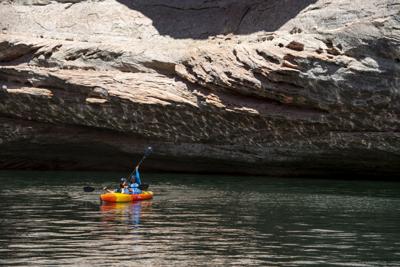The Southern Nevada Water Authority, which manages that state's share of the Colorado River water, has suggested that the time has come for Colorado and its upper Colorado River Basin neighbors to contribute some of its water to help with the situation at Lake Powell and Lake Mead.
In a Dec. 20 letter to Tanya Trujillo, assistant secretary for water and science at the U.S. Department of the Interior, the authority suggested the Upper Basin states — Colorado, Wyoming, Utah and New Mexico — should be required to reduce water use by 500,000 acre-feet, with that water released to Lake Powell.
The reduction would take place whenever Lake Powell is projected to begin a calendar year with water levels at or below 3,550 feet.
As of Dec. 28, Lake Powell is already below that level, at 3,524 feet. The lake hasn't been above 3,550 feet since August 2021, according to the U.S. Geological Survey.
The crisis on the Colorado River is driving efforts by the seven states in the basin to find ways to shore up the water levels at both lakes. Lake Mead's Hoover Dam generates about 4 billion kilowatts of hydroelectric power, enough to serve 1.3 million people in Nevada, Southern California and Arizona. But the levels at Lake Mead, now at 1,044 feet, are dropping to a point where the dam will no longer be able to generate hydroelectricity, known as "dead pool." That level is at 895 feet and the lake is projected to drop to that level sometime in 2025.
A second hydroelectric power plant is at Glen Canyon Dam, on Lake Powell. That plant supplies electricity to about 5 million people through the federal Western Area Power Administration to Wyoming, Utah, Colorado, New Mexico, Arizona, Nevada and Nebraska. Losing the ability to generate power, which would occur at 3,490 feet, would require other forms of power generation — think natural gas — as well as much higher electricity rates.
The commissioner of the Bureau of Reclamation, which operates both lakes, told the seven states of the Colorado River Basin in June to come up with a plan to save 2 million to 4 million acre-feet of water by mid-August, or the bureau would come up with its own plan. That threat, however, proved to be an empty one; Commissioner Camille Calimlim Touton instead gave the states more time and implemented already-agreed to reductions in water use, primarily for Arizona.
The response from the Upper Basin states, which together form the Upper Colorado River Commission, was a five-point plan that didn't actually identify any water savings.
The Dec. 20 letter from John Entsminger, the governor's representative to the authority; and Eric Witkoski, the executive director of the Colorado River Commission of Nevada, was submitted in response to a Nov. 17 notice of intent from the bureau for a supplemental environmental impact statement (SEIS) tied to the 2007 interim guidelines for Lower Basin shortages.
"The inability to reliably release water from Glen Canyon Dam imposes unacceptable risk to Lower Basin water supply and the predictability of that supply," the two wrote in their letter to Trujillo. "Given the risk identified by Reclamation’s recent modeling that Lakes Mead and Powell will decline below their respective power pools, and the consequent risk to public health, safety, and welfare, the preferred alternative should protect sufficient storage in Lake Mead to ensure that 18 months of deliveries necessary to meet public health, safety and welfare can be made by Reclamation."
That alternative is to require the Upper Basin states to reduce their water use by 500,000 acre-feet, they suggested.
But the Upper Basin states have never used their full allotment of the Colorado River, according to Andy Mueller, general manager of the Colorado River District on the Western Slope.
Collectively, the 1922 Colorado River Compact and subsequent agreements dictated the Upper Basin states receive 7.5 million acre-feet per year. Colorado's allocation was set at 3.9 million acre-feet; Utah was set at 1.725 million acre-feet; New Mexico was to be allocated 843,750 acre-feet; and Wyoming was to be allocated 1.05 million acre-feet.
The reality, according to Mueller, is far less.
"The Upper Division states have never used more than approximately 4.6 MAF and their long term, 10-year average is approximately 4.5 MAF. Last year, our consumptive use in the Upper Division states dipped to approximately 3.5 MAF, according to the Upper Colorado River Commission. Colorado may have a paper entitlement to 3.9 MAF but its highest consumptive use year ever according to the USBR was 2.6 MAF in 2011."








(0) comments
Welcome to the discussion.
Log In
Keep it Clean. Please avoid obscene, vulgar, lewd, racist or sexually-oriented language.
PLEASE TURN OFF YOUR CAPS LOCK.
Don't Threaten. Threats of harming another person will not be tolerated.
Be Truthful. Don't knowingly lie about anyone or anything.
Be Nice. No racism, sexism or any sort of -ism that is degrading to another person.
Be Proactive. Use the 'Report' link on each comment to let us know of abusive posts.
Share with Us. We'd love to hear eyewitness accounts, the history behind an article.